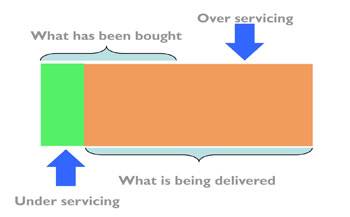
It's important to get levels of serving right in the logistics industry says Steve Twydell of transport management company 3t Logistics.
Servicing customers efficiently is a delicate balance of allocating the right level of staff and resources whilst remaining financially viable. Getting it wrong can have significant financial implications for a business involved in the logistics industry. If you are losing money delivering the service that you have contracted to provide, the problem is likely to be due to one of two factors: a fundamental structural problem in your business or over/under servicing.
As the recession hit in 2008, many companies started to shrink, resulting in increased pressure to increase productivity for frontline staff. Resources were cut and workload increased. Having experienced the problems first hand, I can personally testify to the dramatic rise in levels of stress and anxiety involved in maintaining service during this period.
Companies that have a customer service issue often take the short term approach - apologetically trying to persuade the customer that more resources and better service will soon be forthcoming if they stick with them. Furthermore, with customers demanding increased value for money as their own margins are squeezed, some companies carry out tasks that they are not contractually obliged to do.
Prior to 2008 the logistics industry took a more relaxed approach - if you were doing a good job, creating savings and efficiencies, everyone was happy. The measurement of success was less detailed and more subjective. These intangible measurements have now been replaced with structured KPIs and black and white measures which, although more objective, don't measure all the intangible benefits that a company provides. The result is that companies substitute service failures for additional services to try to balance the areas that they are failing in. See the diagram above:
The green rectangle represents agreed contract services; the overlaying orange rectangle, which produces the square, represents the services that are being provided correctly. In most cases, the actual service provided is greater than the contracted service.
Addressing the service issue
So, how do you fix the problem? One answer is to simply charge the customer for the service they are getting, but this would not be acceptable to most customers, who quite rightly just want at least the service that has been contracted.
The process
Gaining clarity of service provided is the key to resolving the issue, followed by communicating this clarity to customers and staff so that everyone is clear about the service that is provided. The following programme can be implemented to address this:
• Revisit contracted agreements and create clarification amongst staff, customers and carriers to ensure the right levels of service.
• Record the service that is being provided, then for every client, write down exactly what service should be provided.
• Ensure that operating procedures and agreements are accurate and up to date for customers and suppliers.
• Rewrite agreements for the above if necessary so everyone understands what is expected and what is possible.
This process needs to involve agreement across staff and departments so they understand what their responsibilities really are and what they are supposed to achieve. This may also involve creating more precision within job descriptions.
Creating compliance
The next stage is ensuring compliance - more tricky than it sounds. Depending upon the size and evolution of the business, the organisational culture/structure can have a major impact on both clarity and compliance. In some organisations, people assume cross functional roles. The functionality of each department may not have been reviewed for several years, with activities in particular departments that would best fit in others. This mis-functionality necessitates a realignment of roles and responsibilities.
This process may also highlight the capability of employees. This can be an emotional process as it involves examining people at all levels. Do they have the required capabilities, and if they do not, can they be trained? Are they the right fit for the organisation and role? When you understand what people are supposed to be doing, there is a clearer benchmark to measure their capabilities against. It is also easier to agree a framework or a process to get that person to the relevant level.
The issue of customer service is crucial for the logistics industry. Failing to deal with the consequences of under and over servicing could be fatal for your business, so make clarity and compliance the core focus of any improvements.